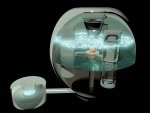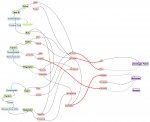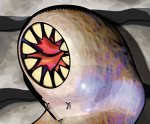Summer Palace
Maps look good, but lettering may get confusing. I especially like the picture of the buildings in the top right.
Scenario—Hooks. Cross reference better. You may have already discussed the ‘why’ in the Dneva in Arnlaug’s Carcass or Castellan Montcolm—so either provide a: “See Area #4 in Arnlaug’s Carcass (or whatever), OR...a quick repeat summary. And/or make some random hooks to make this more modular—what if I just want to steal this adventure to throw in my own campaign?...provide some random hooks that may be used without your storyline thats going on.
A: Palace Environs—this feels jarring. I still dont have a clear picture why Im here due to the Scenario/Hooks above.
3. I went to H1c—good cross reference, but no stats?
2 and 4—any hints/foreshadow of what killed the creatures? Maybe a lost opportunity to increase tension.
Wandering Monsters--
I like the Condition column, but feels too simple. Id rather see: 1-2+1 Giant Stag Beetles—fighting each other over a spider corpse...rather than just Hungry.
#7 Gargantuan Fiendish Monstrous Centipede’s Condition is better, but what is its rival?
B-L Summer Palace
Window stats—I’m not really into the stats (must be different edition) BUT, I love that you make it apparent that they can be broken and entered.
ok...my personal opinion here...your set-up doesn’t work too well. It has the indents and attempts to make it easy to scan, but here is my argument:
Player info---what they can see
DM info—what is secret to the PCs
‘Ancient architecture. Weathered and crumbling.’--this is fine, a little dry for my tastes, but gets point across.
1st floor windows, 2nd and 3rd windows, etc.--this is good info, BUT it should be lower in description in my opinion. This is DM info.
Walls are masonry...stories are 10’ high---this could be player info or DM info.
Roofs are crumbling, red tile----This is Player info..should go in first paragraph of area.
Stealth DC—this is DM info
When this happens...--DM info..careful of if/when scenariors--can open up endless doors of possibilities.
‘The Palace is managed for Tarcho by a tribe of Spider Grubbers’--this is Scenario info
Spider Grubbers are alert—this is DM info
Their guards ask the business, etc.--Are there guards present? This should be in first section for Player info.
Trespassers are met with force, etc.--this is DM info
Grubbers use Spider Climb—DM info—and good tactical stuff!
If dialog is opened---you just opened the door of if/when...do you plan to describe every if/when scenario? Notice your wording of the one up above--”Trespassers found inside the inner walls….” It’s stronger than “If dialog is opened”...Trespassers has no if/when….you could rephrase it by saying “Dialogue attempts lead to grubbers being bedeviled, etc. Hope this suggestion makes sense..
Everything else---holy man, salamander knights, etc.--this might be better in a rumor table or something.
So basically...you got indents which is helpful, but in my opinion, in order to make this easier on the DM—you need to put most of the info into the Player Info section (the first few sentences). This is rough, but something like this:
Ancient architecture, weathered and crumbling concrete walls. One to three story buildings with glazed windows, barred on first floor and shuttered on 2nd and 3rd stories. The cracked walls hold aloft a crumbling roof of red tile.
Windows DC
Walls Climb DC
Roofs—stealth DC...blah blah blah
(imagine if windows, walls, and roofs were bolded in the character info and DM info how easy it would be to locate if a Player asked a question)
Palace is managed by Tarcho---this should all be in the scenario or GM notes before describing the areas of the palace.
‘If dialog is opened’---this could all be part of additional hooks or something…..and onward to a rumor table. i.e. DM’s Notes: Conversing with spider grubbers may reveal these rumors:
1. there is a big ass centipede
2. They allow PCs to run around if they promise to kill it. They give a signet ring to show their loyalty and allow them to explore unmolested.
3. Don’t go near the tree in the temple! (Ettercap druid, see Area #??)
4. A brave, stout man (or whatever describes Proctor Lund) led a group of Salamander Knights, etc….
The map….and B, 1, and 2. Maybe to make it more clear, you add B, B-1, B-2
For B-1 and B-2—I feel like it could be combined. Explain the gate, and beyond PCs see some giant stag beetles eating some corpses, etc…..
Any kind of combat draws the Giant Flies? How about a 65% chance they flies come and enter combat withing 1d4+1 rounds or something.
Same advice for the rest of the sections…
E. Atrium
1. Gates and foyer doors have been hurriedly repaired, etc.--don’t tell, show….Boards have been nailed haphazardly to the doors (or something).
E 2. “The feeling of being watched”--again, don’t tell, show. This is always a hard one for me to describe...but maybe: The breeze blows, etc….branches from a bush shudder suddenly, as if someone had been there and moved position…..or the light glints off an eye in the bushes, but is no longer there…..that’s horrible, but something like that.
F---good cross reference (Omalwera (J4—once finalized, maybe a page number or a pdf link))..
J—3. Servants shrine to Zirax the small god of cabbage—again, show, don’t tell. Maybe the shine is a giant cabbage. Maybe bards have a chance to know what god it is...etc.
Moving Forward---I think this all should be in the beginning DM notes or scenario. Summarize the entire adventure in a few short sentences/paragraphs so the DM knows whats up. This also could beef up hooks, rewards, and/or rumors. This is important—otherwise it feels very jarring and sudden...and I have to hunt for info for the full picture of whats going on instead of just having a short summary in the very beginning.
Monster Roster—cool
“The first area I detailed was a roman-style villa called the
Sommer Palace. This is meant to be run as a social interaction challenge or a commando raid.”
This should be in the DM Summary in the very beginning. Describe each way---(Dialogue may lead to these rumors and/or allowing PCs to explore if they promise to kill centipede, etc.)...or Commando raid—the guards patrol these specific areas, blah blah, every 3 turns….windows can be broken, etc.
I skimmed over most of the other descriptions but focused on the first one to give an example. Let me know if questions or need further clarification. And remember this is just my opinion.


























